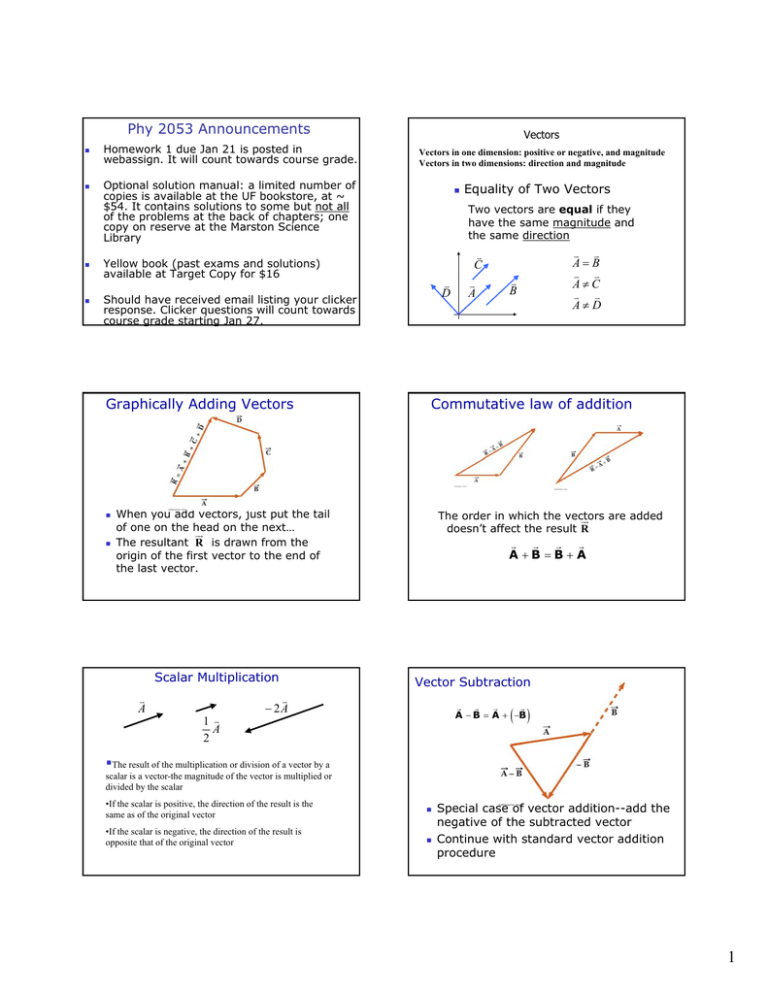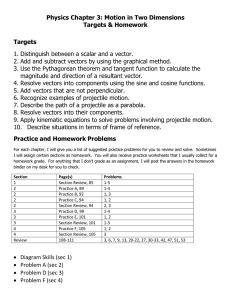Phy 2053 Announcements
advertisement

Phy 2053 Announcements Homework 1 due Jan 21 is posted in webassign. It will count towards course grade. Vectors Vectors in one dimension: positive or negative, and magnitude Vectors in two dimensions: direction and magnitude Optional solution manual: a limited number of copies is available at the UF bookstore, at ~ $54. It contains solutions to some but not all of the problems at the back of chapters; one copy on reserve at the Marston Science Library Two vectors are equal if they have the same magnitude and the same direction v C Yellow book (past exams and solutions) available at Target Copy for $16 v D Should have received email listing your clicker response. Clicker questions will count towards course grade starting Jan 27. Graphically Adding Vectors v A 1 v A 2 v A v B v v A= B v v A≠C v v A≠ D Commutative law of addition When you add vectors, just put the tail of one on the head on the next… ur The resultant R is drawn from the origin of the first vector to the end of the last vector. Scalar Multiplication Equality of Two Vectors The order in which the vectors are added ur doesn’t affect the result R r r r r A +B =B+ A Vector Subtraction v − 2A r r r r A − B = A + −B ( ) The result of the multiplication or division of a vector by a scalar is a vector-the magnitude of the vector is multiplied or divided by the scalar •If the scalar is positive, the direction of the result is the same as of the original vector •If the scalar is negative, the direction of the result is opposite that of the original vector Special case of vector addition--add the negative of the subtracted vector Continue with standard vector addition procedure 1 Adding Vectors Algebraically Vector Components The x-component of a vector is the projection along the x-axis uur ur A x = A cos θ x Ax = A cos θ The y-component of a vector is the projection along the y-axis Ay = A sin θ r r r Then, A = Ax + Ay uur ur A y = A sin θ y These equations are valid only if θ is measured with respect to the x-axis 3.18 A small map shows Atlanta to be 730 miles in a direction 5o north of east from Dallas. The same map shows that Chicago is 560 miles in a direction 21o west of north from Atlanta. Assume a flat Earth and use the given information to find the displacement from Dallas to Chicago. Projectile Motion The x- and y-directions of motion are completely independent of each other Choose a coordinate system and sketch the vectors Find the x- and y-components of all the vectors Add all the x-components Add all the y-components R x = ∑ Ax R y = ∑ Ay Use Pythagorean theorem find The magnitude of the resultant: R= R 2x +R 2y Use inverse tangent function To find the direction of R: θ = tan −1 Ry Rx Projectile Motion Object may move in x and y directions simultaneously: 2D motion The form of two dimensional motion we will deal with is called projectile motion • Ignore air friction • Ignore the rotation of the earth • With these assumptions, object in projectile motion will follow a parabolic path Rules of Projectile Motion The x- and y-directions of motion completely independent The initial velocity v 0 can be broken down into its xand y-components vOx = vO cos θ O vOy = vO sin θ O • y-direction: free fall: a = -g –take the positive direction as upward –uniformly accelerated motion, so the kinematic equations all hold • x-direction: ax = 0 v xo = v o cos θ o = v x = constant x = vxot uniform velocity in the x direction 2 2 • Velocity at any time v = v x + v y and θ = tan−1 vy vx 2 Problem-Solving Strategy Projectile Motion at Various Initial Angles Complementary values of the initial angle result in the same range The heights will be different • Horizontal motion: Use techniques for problems with constant velocity The maximum range occurs at a projection angle of 45o • Vertical motion: Use techniques for problems with constant acceleration. It determines the time in air. Assume that both snowballs are thrown with a speed of 25.0 m/s. The first is thrown at an angle of 70.0° with respect to the horizontal. (b) How many seconds later should the second snowball be thrown after the first in order for both to arrive at the same time? 71. One strategy in a snowball fight is to throw a snowball at a high angle over level ground. Then, while your opponent is watching that snowball, you throw a second one at a low angle timed to arrive before or at the same time as the first one. Assume that both snowballs are thrown with a speed of 25.0 m/s. The first is thrown at an angle of 70.0° with respect to the horizontal. (a) At what angle should the second snowball be thrown to arrive at the same point as the first? (b) How many seconds later should the second snowball be thrown after the first in order for both to arrive at the same time? Some Special Cases of Projectile Motion Object may be fired horizontally The initial velocity is all in the xdirection vo = vx and vy = 0 All the general rules of projectile motion apply Select a coordinate system and sketch the path of the projectile--Include initial and final positions, velocities, and accelerations Resolve the initial velocity into x- and ycomponents Treat the horizontal and vertical motions independently v = vo + at ∆x = v o t + v 2 = vo2 + 2a∆x (2) (3) Non-Symmetrical Projectile Motion 30 m/s 1 2 at 2 (1) Follow the general rules for projectile motion 125 m 3



